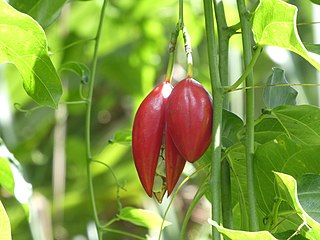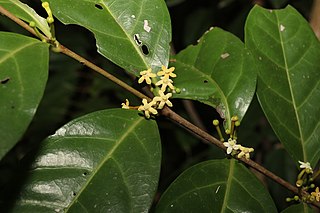Pilidiostigma is a genus of shrubs and small trees in the myrtle family Myrtaceae. All species occur in Australia and one, P. papuanum, also occurs in Papua New Guinea. They are not generally known to horticulture. The species P. sessile is rare.

Jagera is a genus of 4 species of forest trees known to science, constituting part of the plant family Sapindaceae.

Atalaya is a genus of eighteen species of trees and shrubs of the plant family Sapindaceae. As of 2013 fourteen species grow naturally in Australia and in neighbouring New Guinea only one endemic species is known to science. Three species are known growing naturally in southern Africa, including two species endemic to South Africa and one species in South Africa, Eswatini and Mozambique.

Mischocarpus is a genus of about nineteen species of trees known to science, constituting part of the plant family Sapindaceae. They grow naturally from Australia and New Guinea, though Malesia as far north as the Philippines, through SE. Asia, Indo-China and S. China, to India at their farthest west. The eleven Australian species known to science grow naturally in the rainforests of the eastern coastal zone of New South Wales and Queensland, from Newcastle northwards through to north-eastern Queensland and Cape York Peninsula.

Wendlandia is a genus of flowering plants in the family Rubiaceae. It is found in northeastern tropical Africa, and from tropical and subtropical Asia to Queensland.

Atractocarpus fitzalanii, commonly known as the brown gardenia or yellow mangosteen, is a species of plant in the coffee and madder family Rubiaceae. It is found in coastal parts of tropical Queensland, Australia. The beautifully scented flowers and glossy foliage has seen this plant enter cultivation in gardens of eastern Australia.
Hollandaea is a small genus of plants in the family Proteaceae containing four species of Australian rainforest trees. All four species are endemic to restricted areas of the Wet Tropics of northeast Queensland.

Mischarytera is a genus of rainforest trees, constituting part of the plant family Sapindaceae. Four species are known to science as of December 2013, found growing naturally in eastern Queensland, Australia, and in New Guinea. Formerly until 1995, they had names within the genus Arytera, subgenus Mischarytera.

Sarcotoechia is a genus of tropical rainforest trees, constituting part of the plant family Sapindaceae.

Synima is a genus of tropical rainforest trees, constituting part of the plant family Sapindaceae.
Cnesmocarpon is a genus of 4 species of rainforest trees known to science, constituting part of the plant family Sapindaceae.
Dictyoneura is a genus of two-to-three species of rainforest trees known to science, constituting part of the plant family Sapindaceae.

Peripentadenia is a genus of two species of large trees from the family Elaeocarpaceae endemic to the rainforests of northeastern Queensland, Australia. Sometimes they have the common name quandong.

Syzygium forte, commonly known as flaky-barked satinash, white apple or brown satinash, is a tree in the family Myrtaceae native to New Guinea and northern Australia.

Gardenia ovularis is a small tree in the family Rubiaceae. It is endemic to a very restricted part of north east Queensland, namely the coastal rainforests from the Bloomfield River southwards to Etty Bay, and with a further isolated occurrence at Mount Elliot, south of Townsville It was first described by Frederick Manson Bailey in 1893.

Larsenaikia jardinei is a shrub or small tree in the coffee family Rubiaceae, endemic to Central Eastern Queensland in Australia.

Adenia heterophylla, commonly known in Australia as the lacewing vine, is a climbing plant in the family Passifloraceae. It has a broad distribution spanning the equator, from the south eastern corner of China, through Indochina and Malesia, to northern Australia. In Australia it serves as a food plant for larvae of the glasswing, red lacewing and cruiser butterflies.

Cyclophyllum multiflorum is a small tree in the family Rubiaceae reaching 4–10 m (13–33 ft) in height. It is endemic to Queensland and occurs from around Rossville, south to around Mount Elliot. It grows in both rainforest and wet sclerophyll forests, at altitudes from near sea level to about 1,120 m (3,670 ft).

Ixora biflora is a shrub in the family Rubiaceae growing up to 2 m high. It is endemic to northeastern Queensland, Australia, and inhabits the understorey of well developed rainforests. Its main range extends from the vicinity of Rossville to just south of Port Douglas, with isolated occurrences as far south as Mackay.

Psychotria coelospermum is a vine in the coffee family Rubiaceae found only in the Northern Territory and Queensland, Australia. It is a root climber with a slender stem and leaves arranged in opposite pairs, each measuring up to 14 cm (5.5 in) long by 7 cm (2.8 in) wide. Flowers are produced in panicles from October to December, followed by white fruits about 15 mm (0.6 in) diameter from February to June. It grows in swamps and very wet areas in rainforest. It was first described by the Queensland government botanist Frederick Manson Bailey in 1904.















